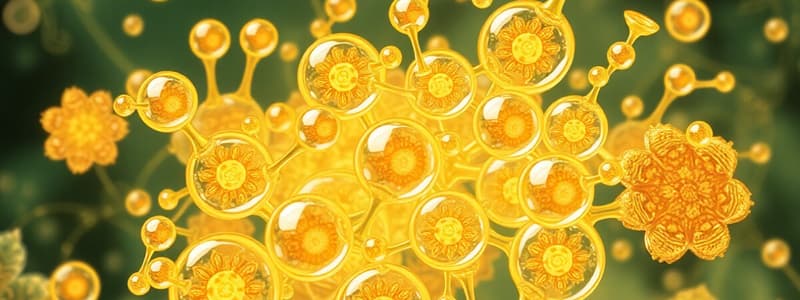Podcast
Questions and Answers
What is the primary source of energy produced by fats compared to carbohydrates?
What is the primary source of energy produced by fats compared to carbohydrates?
- Fats produce energy equal to carbohydrates.
- Fats produce nearly double the energy of carbohydrates. (correct)
- Fats produce energy irrelevant to carbohydrates.
- Fats produce nearly half the energy of carbohydrates.
Which of the following is NOT a function of fats in the body?
Which of the following is NOT a function of fats in the body?
- Insulation against heat loss
- Transportation of oxygen (correct)
- Source of energy
- Protection of organs
What is the colour change observed in the Benedict's test for glucose?
What is the colour change observed in the Benedict's test for glucose?
- From clear to yellow brown
- From blue to orange red (correct)
- From yellow to green
- From red to blue
Which structures are primarily involved in the formation of the DNA double helix?
Which structures are primarily involved in the formation of the DNA double helix?
What are the components of a nucleotide?
What are the components of a nucleotide?
In DNA, which bases pair together according to the complementary base pairing rule?
In DNA, which bases pair together according to the complementary base pairing rule?
What is the role of a gene in an organism?
What is the role of a gene in an organism?
What happens during the ethanol test for fats?
What happens during the ethanol test for fats?
What does a triplet on DNA correspond to?
What does a triplet on DNA correspond to?
What type of lipid is solid at room temperature?
What type of lipid is solid at room temperature?
What is the primary function of fats in thermoregulation?
What is the primary function of fats in thermoregulation?
Which statement correctly describes the role of cholesterol in the body?
Which statement correctly describes the role of cholesterol in the body?
What is the significance of hydrogen bonds in a DNA molecule?
What is the significance of hydrogen bonds in a DNA molecule?
In the bond pairing of DNA, which base pairs with Adenine (A)?
In the bond pairing of DNA, which base pairs with Adenine (A)?
Which process is primarily facilitated by fatty acids in the body?
Which process is primarily facilitated by fatty acids in the body?
What color change is observed in a starch test when iodine is added?
What color change is observed in a starch test when iodine is added?
What characterizes the formation of a triplet in DNA?
What characterizes the formation of a triplet in DNA?
What occurs when fats dissolve in ethanol during an emulsion test?
What occurs when fats dissolve in ethanol during an emulsion test?
Which component is not part of a nucleotide?
Which component is not part of a nucleotide?
Which aspect of genes is essential for protein synthesis?
Which aspect of genes is essential for protein synthesis?
Study Notes
Lipids
- Composed of carbon, hydrogen, and oxygen
- Basic units are fatty acids and glycerol
- Fats are solid at room temperature, oils are liquid
- Important for energy production, cell membrane structure, food reserve, organ protection, insulation, and waterproofing
Importance of Lipids:
- Energy source: Lipids provide nearly double the energy of carbohydrates (39 kJ/gram)
- Cell membrane component: Cholesterol is a lipid that forms part of the cell membrane
- Food reserve: Lipids are stored in the body as a reserve of energy
- Organ protection: Lipids surround and protect organs like the kidneys
- Insulation:
- Thermal insulation: Lipids reduce heat loss
- Electrical insulation: Lipids insulate nerve cells
- Waterproofing: Lipids form a waterproof layer on skin, fur, and feathers
Tests for Starch and Glucose:
- Starch test: Add iodine solution (yellow-brown) to starch, resulting in a blue-black or dark blue color
- Glucose test: Add Benedict's solution (blue) to glucose and heat:
- An orange-red or brick-red precipitate forms, indicating the presence of reducing sugar
- The color change from blue to red depends on the sugar concentration
Testing for Fats (Ethanol or Emulsion Test):
- Step 1: Add ethanol to a sample. Fats dissolve in ethanol, creating a clear solution.
- Step 2: Add drops of water to the clear solution. This results in a milky emulsion, indicating the presence of fat.
DNA Structure:
- Nucleotides: DNA is made up of smaller units called nucleotides
- Each nucleotide contains a base: adenine (A), cytosine (C), guanine (G), and thymine (T)
- Double helix: A DNA molecule consists of two chains of nucleotides coiled around each other, forming a double helix.
- Hydrogen bonds: The two chains are held together by hydrogen bonds between the bases of opposing strands.
- Complementary base pairing:
- Adenine (A) always pairs with thymine (T)
- Cytosine (C) always pairs with guanine (G)
Importance of DNA:
- Cell activity control: DNA regulates cellular processes
- Heredity: DNA transmits genetic information from parents to offspring through genes
Genes:
- A sequence of bases on DNA that codes for a specific protein
- Each gene contains a series of code words for protein synthesis
- Each code word (triplet) consists of 3 bases and corresponds to a single amino acid in a protein.
Lipids
- Composed of carbon, hydrogen, and oxygen
- Basic units are fatty acids and glycerol
- Fats are solid at room temperature
- Oils are liquid at room temperature
Importance of Fats
- Source of energy in respiration (produces nearly double the energy of carbohydrates, about 39 kl/gram)
- Part of the cell membrane (cholesterol)
- Stored in the body as a food reserve
- Protection for organs (e.g., kidneys)
- Insulation (thermal and electrical)
- Waterproof layer for skin, fur, and feathers
Starch Test
- Add iodine solution (yellow-brown color)
- Starch turns blue-black or dark blue
- If the color remains yellow-brown, starch is not present
Glucose Test
- Add Benedict's solution (blue color) and heat
- Orange-red or brick-red precipitate forms
- Gradual color change from blue to red indicates sugar concentration
- This test is known as the Benedict's test
Fat Test
- Add ethanol, fats dissolve forming a clear solution
- Add drops of water to the clear solution, a milky emulsion forms
- This test is known as the ethanol or emulsion test
DNA Structure
- Made of smaller molecules called nucleotides
- Each nucleotide contains a base: A, C, G, and T
- DNA molecule has two chains of nucleotides coiled around each other, forming a double helix
- Chains are held together by hydrogen bonds between bases of opposite strands
- A always bonds with T, and C with G (complementary base pairing)
Importance of DNA
- Controls cell activity
- Transfers features from parents to offspring through genes
Genes
- Sequence of bases (genetic information) that codes for a protein
- Each gene carries a series of code words for protein synthesis
- Each code word on DNA is made up of 3 bases (a triplet)
- Each triplet corresponds to one amino acid in a protein
Studying That Suits You
Use AI to generate personalized quizzes and flashcards to suit your learning preferences.
Description
This quiz covers the composition, importance, and functions of lipids in biological systems. Learn about the basic units of lipids, their role in energy production, and their significance in cell membrane structure and organ protection. Test your understanding of lipid properties and related biochemical tests.




